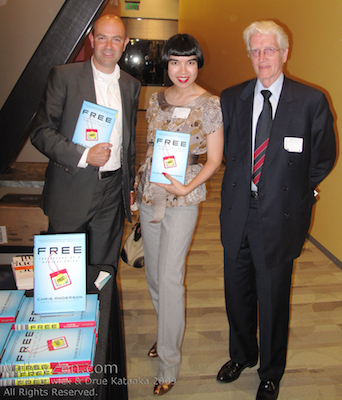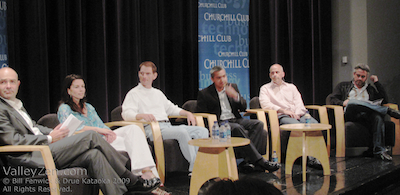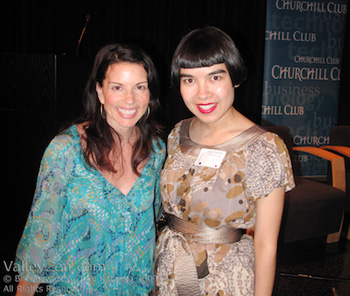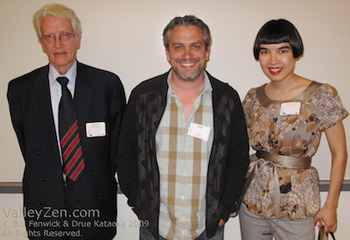Chris Anderson, Wired Editor-in-Chief leads “FREE” Panel

Drue and Bill were invited to attend the Churchill Club’s July 23, 2009 program, held at Microsoft’s campus in Mountain View, CA, “The Free Economy: How Companies Make Money From Giving Things Away.” Chris Anderson, whose latest book FREE: The Future of a Radical Price (released days before the program) was the moderator of an outstanding panel including five founders and/or CEOs of companies that produce products made of bits. The event started with a short context-setting statement by Chris. He explained how the “zero”-cost of bit product reproduction makes it possible for companies to make money by giving away a large quantity of a product in order to sell at a “Freemium” price a much smaller quantity of the digital product.
The Zen of Free
Before the internet, one could say (in general) that a good was either “free” or “not free.” However, today the meaning of FREE has been forever transformed by the internet and is constantly evolving. Online, a good is not purely “free” or “not free.” It can be both. This reminded us of the Zen concept of “not one” and “not two,” where “not two” negates a dividing of the whole into two parts, i.e., dualism, and “not one” refers to non-dualism. Movement between “not one” and “not two” characterizes Zen’s third perspective. This third perspective is harder to define, but more in keeping with today’s “free” and what “free” will become in the future.
The Speakers
Gina Bianchini, CEO at Ning (offers platform where users have created 1.3M social networks with 28M registered users); Joe Kennedy, CEO and President of Pandora; Ranjith Kumaran, Founder and CTO of YouSendIt; Joe Sipher,  Co-Founder and CTO of Pinger; and Neil Young, CEO of Ngcomo, spent the next hour+ providing a variety of views of Free as a marketing method for monetizing digital products and services. Some of them have succeeded in monetizing their companies’ offerings, while others are still trying to figure it out. All agreed that advertising revenues are unlikely to sustain a bit offering– unless it can deliver many millions of eyeballs to potential advertisers.
Co-Founder and CTO of Pinger; and Neil Young, CEO of Ngcomo, spent the next hour+ providing a variety of views of Free as a marketing method for monetizing digital products and services. Some of them have succeeded in monetizing their companies’ offerings, while others are still trying to figure it out. All agreed that advertising revenues are unlikely to sustain a bit offering– unless it can deliver many millions of eyeballs to potential advertisers.
Free is Cheaper to Market
Perhaps because most, if not all, panel members have grown up in a digital world, the panel did not discuss obstacles and other significant costs in creating a market for high tech products made of atoms (as opposed to bits).  In a physical world, manufacturers of innovative consumer products and services made of atoms would spend years of effort and lots of money to educate high-end consumers about the merits of their products and how to use them. They would also spend heavily on creating distribution channels to educate, train and assist retail outlets, so they could do the pre-sale consumer education and training as well as post-sale servicing.
In a physical world, manufacturers of innovative consumer products and services made of atoms would spend years of effort and lots of money to educate high-end consumers about the merits of their products and how to use them. They would also spend heavily on creating distribution channels to educate, train and assist retail outlets, so they could do the pre-sale consumer education and training as well as post-sale servicing.
In the early days of high tech, there were no retail outlets capable of providing pre- and post-sale services for such products. When hi-fidelity stereo products were first offered to the general public, there were no high tech consumers other than a few thousand engineering types. While a music fan could recognize the differences between low-fi and high-fi sounds, they were completely baffled by all the knobs, switches and interconnections required to create a music system out of components. Regarding distribution, expensive trials using drug, furniture and television retail outlets failed miserably. Few sales clerks or service personnel in appliance or other retail stores could do anything more than turn on the power. The same was true for personal computer hardware and software. Fortunately for personal computers, the channels that had been created for hi-fi products could serve as their initial distribution channels, retail outlets and service organizations. Advertising’s primary economic function in an atoms economy is to educate a potential consumer of the atom product’s existence and functions (later in the life of an atom products, the goal of advertising was to build an affinity between the consumer and branded product).

When the product or service is made of bits instead of atoms, many innovative (and free!) business models for educating and servicing consumers become possible. Using Free as a marketing method in a bits economy (where the marginal costs of reproduction are near zero) greatly facilitates consumer adoption. The accompanying time and costs are nearly eliminated (delivery for products made of bits uses the Internet, which is both fast and free). When product adoption ramps up among the technological elite due to the free distribution, discussion forums and blogs spontaneously emerge to answer customer questions—facilitating the otherwise perilous transition from elite adoption to mass market. The physical world costs of consumer, distributor and servicer education are greatly reduced and possibly eliminated. Thus, bit products that are free have a greater prospect of going viral and finding near-instant market success. Free is cheaper to market.
Missed the Event? Watch the Video!
Attending “The Free Economy” program was thought provoking and a very good use of time. All panel members and audience participants delivered views and questions that make viewing the Churchill Club’s video a “must” for anyone involved in bit products and services. If you missed the event, ValleyZen highly recommends watching the video. Another Churchill Club success!



This is a very interesting point: offering a product for free is an implicit subsidy towards the marketing, distribution and support costs.
It follows that reaching critical mass QUICKLY in the following fields is critical for the success of a new digital product:
- marketing: reaching influencers such as leading (and vocal!) authorities in the field
- distribution: achieving search engine visibility on google/yahoo/msn, and presence on leading niche websites (such as download.com for software)
- support: nurturing a network of tech-savvy and support-minded individuals
Accomplishing these goals very quickly (within weeks from launch) is the key to success in a digital world. Otherwise, customers can get very quickly disillusioned with the product. But to achieve these goals, a company needs either lots of cash or lots of skill.